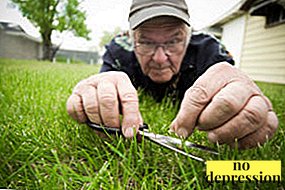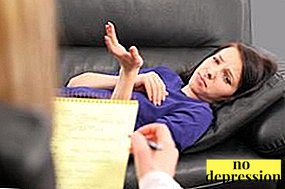Neurosis of obsessive-compulsive disorder, or, in other words, obsessive-compulsive disorder, is mental disorderin which a person has obsessive thoughts, ideas, images, ideas, desires that are extremely difficult or impossible to control, and he tries to cope with them by performing various rituals, the fulfillment of which also gives him pronounced discomfort.
Main symptoms of obsessive neurosis in adults, there is a clear cyclical nature: an obsessive state arises, followed by the appearance of anxiety, fear or other discomfort, and then the person performs the ritual to complete this cycle for a short period of time.
General information and diagnosis decoding

OCD diagnosis in psychiatry - what is it? How does OCD mean?
Obsessive compulsive disorder refers to mental disorders, is included in a large group of neuroses, and is often accompanied by other mental illnesses, such as depressive syndrome, anxiety disorder, panic disorder, astheno-neurotic syndrome, post-traumatic stress disorder.
The title "obsessive-compulsive disorder" hidden symptomatic features of the disease:
- obsessions. Obsessions are conditions that a person cannot remove by volition, therefore repeats compulsive actions over and over again that can interrupt or alleviate discomfort, anxiety, and fear for a while;
- compulsions. These are rituals that a person repeats in order to cope with obsessions.
Example: a young girl prone to developing neurosis-like states due to personality traits becomes a witness to a fire in a nearby apartment, and this event triggers the development of obsessive-compulsive disorder.
Several times a day obsessions appear in her head: images of a burning apartment, illuminated objects, intrusive chains of reasoning about exactly how a fire can start.
Before leaving home she performs compulsive rituals: turns off all electrical appliances, shuts off the valve on the gas pipe and checks whether she did everything correctly, several times.
Repeatedly, the obsessions forced her to return to the apartment when she had already left her, and to check everything again, despite the fact that everything was in order there.
Obsessive compulsive disorder is a common mental disorder - 2-5% of people have it - and most often occurs in residents of developed countries, especially those who have been living in megalopolises for a long time.
Why do obsessive actions occur? Find out from the video:
Obsessive personality type
There are a number of personality traits that increase the likelihood that a person will have obsessive-compulsive disorder, and they are laid back in childhood.
Characteristics of obsessional type people:
 Perfectionism. They strive to accomplish everything in the best possible way, carefully eyeing the smallest details. If you need to study something, a person with perfectionism will find even something that is indirectly relevant, if you need to do something, he will be extremely diligent, self-critical, and there is a high probability that he will not be satisfied with the result, even if his employers are delighted.
Perfectionism. They strive to accomplish everything in the best possible way, carefully eyeing the smallest details. If you need to study something, a person with perfectionism will find even something that is indirectly relevant, if you need to do something, he will be extremely diligent, self-critical, and there is a high probability that he will not be satisfied with the result, even if his employers are delighted.- Discipline, highly developed self-control. They tend to carefully follow the rules, including those thought up by themselves, they like to live according to the daily routine, they prefer to plan everything in advance. Such people play well socially important roles, are successful in work and other activities, but they are clumsy for why it is difficult to choose a system and that it has a completely different foundation, consisting of feelings and emotions.
- The desire for knowledge, reasoning. Search and assimilation of information, knowledge, they seek to put at the forefront, and any cognitive activity almost always prevails over other values. They like to reason, draw conclusions, build complex logical chains in their heads and successfully use their abilities, skills and knowledge to achieve goals.
- The depreciation of the importance of emotions, difficulties in their expression. Emotions, feelings, they tend to push away, tend to consider them a sign of weakness, lack of discipline. When feelings overwhelm them, they do not want to speak, drown out their work. They know how to express them badly, which leads to an increase in internal nervous tension and becomes a prerequisite for the development of mental disorders, including OCD.
- The desire to show themselves from the best sideincluding before himself. They experience acute discomfort if they make mistakes, even miserable ones, if they lose control of themselves, behave at least to an insignificant degree inappropriately, even if they are not. They are also afraid of panic that people around will think about them badly.

Obsessive personality type is inherent in people whom society considers potentially successful.
Their abilities, perseverance, perfectionism, aimed in a good direction, give them the opportunity to achieve significant heights.
But the tendency to think, excessive self-control, blocking the emotional component, the desire to do everything as best as possible make them vulnerabletherefore, such people may develop neurosis.
This personality trait is laid in childhood and is associated with the pressure of parents wanting their child to be the best. They punish for mistakes, even insignificant ones, and actively praise them for their successes, criticize them for displaying emotions and losing self-control.
In the future, the children of such parents will retain the formed features throughout their lives. try to match unattainable, imposed ideal.
Obsessive compulsive personality type! What is this personality type characteristic of? Find out from the video:
Causes of development
The biological causes of deviations are associated with disruptions in the metabolism of serotonin and norepinephrine, which leads to the appearance of pathological anxiety in humans. In turn, these failures arise due to:
 Genetic predisposition. Some defects in the genes that cause a failure in metabolism are inherited. Half of people suffering from obsessive-compulsive disorder have relatives who have had or have the same disease.
Genetic predisposition. Some defects in the genes that cause a failure in metabolism are inherited. Half of people suffering from obsessive-compulsive disorder have relatives who have had or have the same disease.- Traumatic brain injury. Severe traumatic head injuries can seriously impair the performance of the brain, so people with a history of TBI are more likely to suffer from mental disorders.
- Infectious diseases. Problems in metabolism can also be associated with complications remaining after previous infectious diseases, such as viral hepatitis, measles, Filatov disease.
- Hyperthyroidism. Thyrotoxicosis entails the appearance of pronounced changes in mental health: a person becomes anxious, irritable, and emotionally unbalanced.
- Chronic GI Disease, in particular gastroduodenitis and pancreatitis.
- Strong mental injury. These include severe episodes of violence, rape, the death of a loved one, some acute episode that is firmly remembered (for example, if an untrained person sees a live corpse with a torn abdominal cavity, this can be a traumatic experience for him).
- Prolonged acute stress. Problems at work, bankruptcy, family scandals, toxic, exhausting relationships with relatives, friends or a loved one can also trigger the development of obsessive-compulsive disorder.

Usually the development of the disease triggers the trigger, which can be traumatic experience.
All kinds of obsessions, starting with obsessive thoughts and ending with obsessive memories, doubts, desires, in people with obsessive-compulsive neurosis are somehow related to their fears and repressed emotions, to what they consider painful, dangerous, or extremely unacceptable.
For example, fear of death will cause obsessions associated with it: a person will involuntarily scroll through the scenarios of his own death in his head and fear them; he may even have obsessive images of how he commits suicide.
Suppressed sexual desires will generate obsessive imagesrelated to sexual actions, thoughts, often those that the patient himself considers deeply unacceptable, therefore, when such thoughts and desires appear, he will experience acute shame and anxiety.
Symptoms of neurosis and types of obsessions
The main symptom of obsessive neurosis is having a recurring cycle-compulsionHowever, the severity of the deviation can vary from mild, when the disease does not cause a person significant discomfort, to extremely severe, in which the patient is deeply immersed in a cycle of repeated obsessions and rituals, unable to work, learn.
Features of the course of obsessive neurosis:
 Continuous. Symptoms persist for a long time. Some patients coexist with their neurosis for decades, which extremely negatively affects their personality and behavior.
Continuous. Symptoms persist for a long time. Some patients coexist with their neurosis for decades, which extremely negatively affects their personality and behavior.- Uneven, having periods of remission and exacerbation. Usually exacerbation of OCD is associated with changes in a person’s life (relocation, stress, lack of rest and sleep, mental overload, death of loved ones).
- Gradually progressive. The most severe variant of the course of neurosis, which requires an urgent start of treatment, since without appropriate therapy a person will plunge into the disease with his head, and it will affect all his decisions, will force him to shut himself off from the world and the people around him.
Types of obsessive states:
- Obsessive phobias. There are a huge number of phobias, from common ones such as tanathobia, insectophobia, mishophobia, claustrophobia, to extremely rare and unusual ones, such as fear of even or odd numbers, fear of things on the left, fear of receiving gifts.
- Obsessive thoughts. These are thoughts that persist for a long time in the head of the patient, prevent him from concentrating, and it is very difficult for him to throw them out of his head. These can be words from a song, a sticky melody, a quote from a movie hero. This category of obsessive thoughts in most cases is quite harmless: they occur even in healthy people. There are also obsessive thoughts that cause a person to have acute discomfort and anxiety, disagree with his beliefs, and are associated with fears (for example, thoughts that offend God for a deeply religious person).
- Intrusive actions. These include movements that are repeatedly performed by man without the participation of volitional efforts. For example, biting lips, winking, blinking, yawning, twitching with foot, head, tapping fingers on the table, biting nails, cuticles.
 Obsessive doubts. They are associated with a person’s anxiety about the correctness of performing certain actions. He worries about whether he turned off the taps and burners in the apartment before leaving, whether he wrote the address on the envelope correctly, or if he made a mistake writing down the phone number, or if he accidentally wrote the wrong word, rewriting the text. Because of these obsessions, a person repeatedly re-checks everything, which takes a lot of time and energy.
Obsessive doubts. They are associated with a person’s anxiety about the correctness of performing certain actions. He worries about whether he turned off the taps and burners in the apartment before leaving, whether he wrote the address on the envelope correctly, or if he made a mistake writing down the phone number, or if he accidentally wrote the wrong word, rewriting the text. Because of these obsessions, a person repeatedly re-checks everything, which takes a lot of time and energy.- Obsessive memories. They are associated with traumatic, unpleasant events that occurred in different life periods. Man involuntarily scrolls them in the head and re-experiences a range of negative emotions.
- Compulsive anxiety fail in anything, show yourself from the bad side. May have a connection with events that await a person in the future (for example, the patient winds himself up, imagining that something will go wrong, he will not speak well, they will laugh at him), and not have it.
OCD - the answer of the psychologist:
OCD and pregnancy
For most women, the birth of a child - serious, responsible step. And the higher the mind, the prudence of a woman, the more she tries, so that both pregnancy and childbirth are as good as possible, and the child is born healthy, grows happy and has everything he needs for full development.

Many women have pronounced symptoms of obsessive-compulsive disorder and other mental abnormalities for the first time during pregnancy and after the birth of their first child, which is connected both with global hormonal changes that affect mental health, and with radical changes in a woman's life, the need to adapt to new rules .
Obsessions of pregnant and newly born women closely related to the child, his health and life.
They are afraid that they will harm him, kill him, that something will happen, because of what he will be born with violations, that the birth will be bad, doctors will make a mistake, that the child will be born dead or die in the first months of life.
Especially high probability of neurosis, if a woman was a negative experienceassociated with pregnancy (miscarriages, forced abortions due to a genetic defect in the embryo, missed abortion, death of the child during childbirth) and if she was anxious and suspicious before the pregnancy.
Psychotherapist tips for pregnant women:
- Tell someone you trust about your concerns., such as a friend, mother, partner. Their support, stories about their own experiences and the experiences of loved ones, warmth and care are ways to mitigate or completely eliminate anxiety.
- Analyze your alarms whenever possible and try to convince yourself that you are doing everything for the child that depends on you. In addition, many fears are associated with the action of hormones, which will eventually pass.
- Study information about OCD, read the forums of pregnant women, which describe their problems. Understanding that this hard experience is not unique and many women go through and have done the same thing can also help.
If the symptoms of obsessive compulsive disorder are severe, consult a psychotherapist.
Treatment
When the first signs of OCD appear, it is important not to ignore them and try to help yourself. In some cases, mild forms of the disease can be eliminated if you change your own life.
Psychotherapist Tips:
 try to increase the duration of rest, correct the mode of the day, sleep daily for at least 6-8 hours;
try to increase the duration of rest, correct the mode of the day, sleep daily for at least 6-8 hours;- more often engage in hobbies, read books, watch movies, take a walk in the fresh air;
- moderate physical activity favorably affects the mental state, so even five-minute morning exercises can reduce anxiety;
- avoid information that always evokes negative emotions;
- communicate more often with people who treat you favorably;
- pass a general examination, pass tests: some physical diseases cause symptoms similar to signs of neurosis.
If these measures were not effective, and the neurosis manifests itself strongly enough, it is necessary to contact the specialists and begin treatment.
Obsessive compulsive disorder treated with medication and psychotherapy. Medications are selected based on the characteristics and severity of the disease, may include antidepressants (Imipramine, Amitriptyline, Setralin) and tranquilizers (Diazepam).
Cognitive-behavioral therapy is considered the most effective in obsessive-compulsive disorder neurosis. Also, the patient is taught the method of stopping thoughts, which allows you to fight obsessions.
Timely started psychotherapeutic treatment can significantly improve the quality of life of the patient, and the skills he received during therapy will allow him to help himself if the disease returns.
Obsessive compulsive disorder - self-help techniques:

 Perfectionism. They strive to accomplish everything in the best possible way, carefully eyeing the smallest details. If you need to study something, a person with perfectionism will find even something that is indirectly relevant, if you need to do something, he will be extremely diligent, self-critical, and there is a high probability that he will not be satisfied with the result, even if his employers are delighted.
Perfectionism. They strive to accomplish everything in the best possible way, carefully eyeing the smallest details. If you need to study something, a person with perfectionism will find even something that is indirectly relevant, if you need to do something, he will be extremely diligent, self-critical, and there is a high probability that he will not be satisfied with the result, even if his employers are delighted. Genetic predisposition. Some defects in the genes that cause a failure in metabolism are inherited. Half of people suffering from obsessive-compulsive disorder have relatives who have had or have the same disease.
Genetic predisposition. Some defects in the genes that cause a failure in metabolism are inherited. Half of people suffering from obsessive-compulsive disorder have relatives who have had or have the same disease. Continuous. Symptoms persist for a long time. Some patients coexist with their neurosis for decades, which extremely negatively affects their personality and behavior.
Continuous. Symptoms persist for a long time. Some patients coexist with their neurosis for decades, which extremely negatively affects their personality and behavior. Obsessive doubts. They are associated with a person’s anxiety about the correctness of performing certain actions. He worries about whether he turned off the taps and burners in the apartment before leaving, whether he wrote the address on the envelope correctly, or if he made a mistake writing down the phone number, or if he accidentally wrote the wrong word, rewriting the text. Because of these obsessions, a person repeatedly re-checks everything, which takes a lot of time and energy.
Obsessive doubts. They are associated with a person’s anxiety about the correctness of performing certain actions. He worries about whether he turned off the taps and burners in the apartment before leaving, whether he wrote the address on the envelope correctly, or if he made a mistake writing down the phone number, or if he accidentally wrote the wrong word, rewriting the text. Because of these obsessions, a person repeatedly re-checks everything, which takes a lot of time and energy. try to increase the duration of rest, correct the mode of the day, sleep daily for at least 6-8 hours;
try to increase the duration of rest, correct the mode of the day, sleep daily for at least 6-8 hours;

